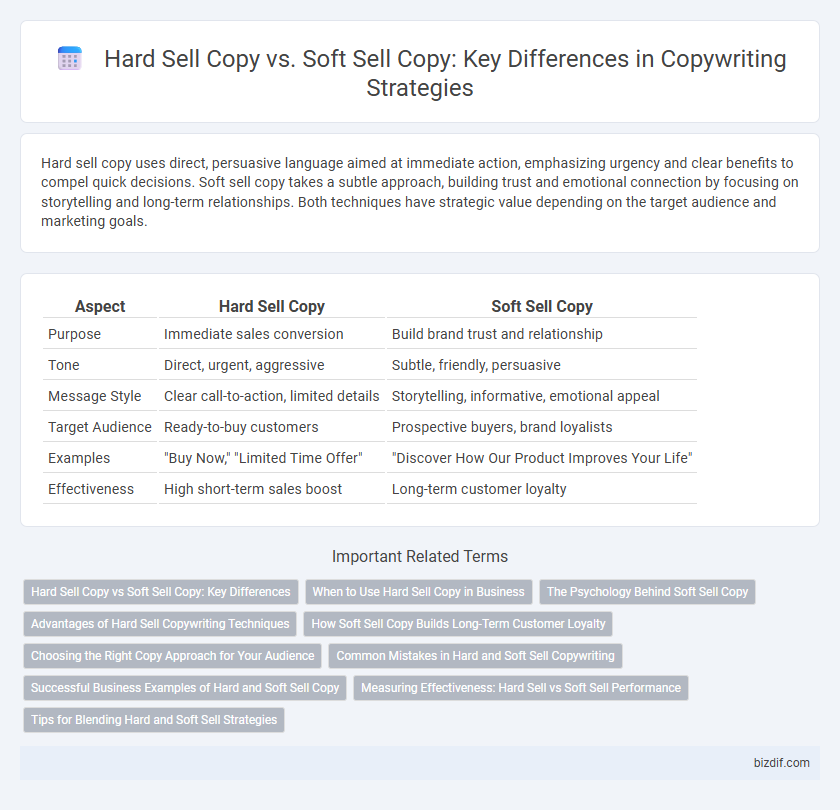Hard sell copy uses direct, persuasive language aimed at immediate action, emphasizing urgency and clear benefits to compel quick decisions. Soft sell copy takes a subtle approach, building trust and emotional connection by focusing on storytelling and long-term relationships. Both techniques have strategic value depending on the target audience and marketing goals.
Table of Comparison
| Aspect | Hard Sell Copy | Soft Sell Copy |
|---|---|---|
| Purpose | Immediate sales conversion | Build brand trust and relationship |
| Tone | Direct, urgent, aggressive | Subtle, friendly, persuasive |
| Message Style | Clear call-to-action, limited details | Storytelling, informative, emotional appeal |
| Target Audience | Ready-to-buy customers | Prospective buyers, brand loyalists |
| Examples | "Buy Now," "Limited Time Offer" | "Discover How Our Product Improves Your Life" |
| Effectiveness | High short-term sales boost | Long-term customer loyalty |
Hard Sell Copy vs Soft Sell Copy: Key Differences
Hard sell copy emphasizes urgency and direct calls to action, using persuasive language to prompt immediate purchases, often featuring bold claims and limited-time offers. Soft sell copy relies on subtle persuasion, building trust and brand affinity through storytelling, emotional appeal, and long-term relationship focus rather than immediate sales. Key differences include tone, approach to consumer engagement, and the psychological triggers employed to influence buyer behavior.
When to Use Hard Sell Copy in Business
Hard sell copy is most effective when targeting customers who require urgent purchasing decisions, such as during limited-time offers or clearance sales. It drives immediate action by emphasizing strong calls-to-action, time-sensitive incentives, and clear benefits. Businesses in competitive markets or high-pressure sales environments benefit from hard sell strategies to maximize conversion rates quickly.
The Psychology Behind Soft Sell Copy
Soft sell copy leverages psychological principles like emotional appeal, trust-building, and subtle persuasion to influence consumer behavior without pressure. It engages the audience by addressing their needs and desires, fostering a sense of connection and authenticity. This approach prioritizes long-term relationship-building, encouraging gradual decision-making and brand loyalty.
Advantages of Hard Sell Copywriting Techniques
Hard sell copywriting techniques deliver clear, direct calls to action that create a sense of urgency, driving immediate sales and conversions. This approach effectively targets impulse buyers and emphasizes product benefits with persuasive, straightforward language. Brands leveraging hard sell copy experience higher response rates in time-sensitive promotions and competitive markets.
How Soft Sell Copy Builds Long-Term Customer Loyalty
Soft sell copy fosters long-term customer loyalty by emphasizing trust, emotional connection, and brand storytelling that resonates deeply with the audience. It prioritizes value and relationship-building over immediate sales, encouraging repeat engagement and sustained brand affinity. This approach cultivates a loyal customer base by aligning messaging with customer needs and preferences, leading to higher lifetime value and advocacy.
Choosing the Right Copy Approach for Your Audience
Hard sell copy uses direct, urgent language to prompt immediate action, ideal for audiences seeking clear, straightforward solutions. Soft sell copy employs subtle persuasion and storytelling, resonating with customers who prefer relationship-building and emotional engagement. Understanding your audience's preferences and buying behavior helps determine whether a hard sell or soft sell approach will most effectively drive conversions.
Common Mistakes in Hard and Soft Sell Copywriting
Common mistakes in hard sell copywriting include overly aggressive language that alienates the audience and lack of emotional engagement, leading to reduced trust and conversion rates. Soft sell copywriting often falters by being too vague or indirect, causing the message to lose urgency and clarity. Both approaches suffer when failing to align the tone and call-to-action with the target audience's preferences and buying behavior.
Successful Business Examples of Hard and Soft Sell Copy
Hard sell copy drives immediate action through direct, persuasive language, as exemplified by companies like GoDaddy, whose urgent, benefit-focused ads boost rapid conversions. Soft sell copy builds brand trust and emotional connection over time, with brands like Apple using storytelling and subtle messaging to cultivate loyal customer relationships. Successful businesses strategically blend both approaches to maximize impact and resonate with diverse audience preferences.
Measuring Effectiveness: Hard Sell vs Soft Sell Performance
Hard sell copy typically drives immediate conversions by using direct, urgent language that appeals to impulse buyers, making its effectiveness measurable through quick sales spikes and click-through rates. Soft sell copy focuses on building brand trust and customer relationships over time, with performance metrics better reflected in engagement rates, customer retention, and long-term brand loyalty. Analyzing key performance indicators like conversion rates for hard sell and lifetime customer value for soft sell provides a balanced understanding of their respective impacts.
Tips for Blending Hard and Soft Sell Strategies
Blending hard sell and soft sell copywriting strategies requires balancing urgency with relationship-building to maximize conversions while maintaining customer trust. Incorporate clear calls to action alongside empathetic storytelling that addresses customer pain points and benefits, enhancing emotional appeal and credibility. Use data-driven insights to tailor the intensity of the sell based on audience segmentation, ensuring messages resonate effectively without overwhelming potential buyers.
Hard Sell Copy vs Soft Sell Copy Infographic

 bizdif.com
bizdif.com